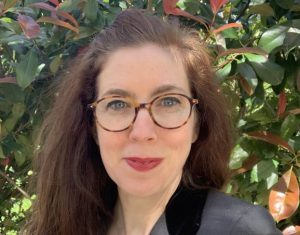
From the start, Storyplace has aimed to bring diverse perspectives to regional stories and storytelling. It was important to make room for varied perspectives so that the story of regional NSW could be told in new and engaging ways.
To better understand how these stories are created, we asked one of the Storytellers, Fiona Starr.
Fiona is a historian, archaeologist, and curator with over 20 years of experience sharing stories from Australia’s history. She has worked as a curator for Sydney Living Museums (now known as Museums of History NSW) and Fairfield City Museum & Gallery and consulted with museums and heritage sites across Australia.
Now, let’s get to know Fiona a little better.
What led you to Storyplace?
I have always been fascinated with all the physical remains of the past. Objects witness history and carry with them the signs and scars of how people interacted with them. Being an archaeologist, curator, and material culture historian, I love investigating objects or places so that I can position them in time.
Storyplace helps bring Australian social history to life, all while showing the true value of regional museums – I think it was natural I would be drawn to it.
To you, what is the difference between writing history and storytelling?
I think history writing can be presented in a simple, detached way, whereas storytelling might be more evocative. It conjures up a time in the past for the reader and appeals to their personal interests and emotions. I like to think that the best history writing has always incorporated elements of storytelling. Historical accuracy and individual interpretation can go hand in hand.
What is your process to get to the story?
We are often lucky to have a few contextual details about historical objects like who made or used it, or at least, who donated it to the museum. This kick-starts my research into primary sources such as historical newspapers, archival records, and genealogy databases.
Sometimes very few details survive, or none at all. In those cases, I examine the object for its physical details – form, colour, materials, decoration, inscriptions, damage, repairs, etc. – and then I use those details to make inferences about how old it might be, who might have made it or used it, where, and how.
All those clues begin to build a scaffold of information and as the process continues one or two aspects usually begin to stand out to me. Something curious which begins to frame the story.
Many of the Storyplace stories I have written begin with scene-setting. I think this places the object in a moment in time and makes the story immediately engaging. That way, you are actually interested in finding out the historical details that follow.
What are you looking out for while researching? How do you know when you have enough material to make a story work?
I look for historical details about the objects that are quirky, curious, or unexpected, but I don’t always find them. I also look for alternative stories or a previously unconsidered perspective. The stories usually begin to take form once I’ve identified a moment in time when the object was in use. This helps frame the story, and then, rather than wondering if I have enough material, it’s usually a matter of knowing what material to leave out.
What has been challenging about writing these stories? Conversely, what has brought you the most joy?
The greatest challenges have been keeping each of the object stories unique and enjoyable to read while trying to wrangle multi-faceted stories – all in a tight word count! I also find it hard to know when to stop going off on a research tangent, from burrowing further into a rabbit hole, and just get on with what’s already evident.
On the other hand, it’s also tricky finding an interesting story angle when nothing at all is known about the history of an object, or if, at first glance, it doesn’t appear to have any unique features that provide clues into its past.
In saying that, overwhelmingly, it’s a very rewarding process to jump into the small windows of personal and community history that live in these objects. The personal connections have been fascinating, and it’s been wonderful to have the occasional opportunity to chat with people who made or owned the objects. The incredible diversity of regional stories and the details they hold about people’s lives – many of which have long been forgotten – has been so surprising.
What are some of the stories you have told on Storyplace which readers shouldn’t miss out on?
I especially like ‘That’s for Spirits’ which tracks the life of a well-travelled stoneware alcohol bottle, ‘Clanging of the Locks’ gave me a glimpse into Maitland Gaol, ‘William’s Pitiful Plight’ made me sit with the moment an orphan boy becomes an indentured servant, and ‘A Tall Tale or True?’ was a fun investigation into the enduring mystery of an early colonial chair.
I am also fond of any about photographic prints, like ‘Out of the Wreckage’. I can reveal so much – the photographer犀利士
behind the camera, the moment in time being captured, even the life of the photographic print itself.
Big thanks to Fiona for giving us a glimpse behind the curtain at Storyplace.
(Thanks to Bren Donnellan for interviewing Fiona)

